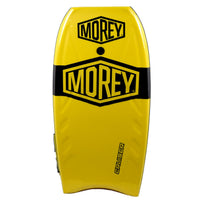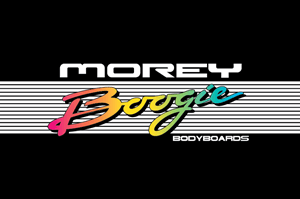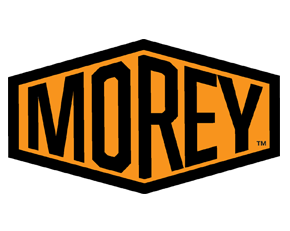
Morey Cruiser 42.5" Bodyboard
Morey
THE BASICS Want to get into bodyboarding on a budget? The Morey Cruiser was made for you. → LARGER RIDER? Check out the Morey Big Kahuna. → WANT ...
View full detailsBeach season is here, and you may want to upgrade that old boogie board you have been using for the past few seasons. Or should you get a bodyboard?
Is there even a difference between a boogie board and a bodyboard?
This is one of the most commonly asked questions we get, so let’s settle the confusion!
The act of riding waves on a board was first observed in Hawaii, as early as 1778.
Back then, the name for these boards was “alaia”, and they were ridden on one's belly, knees, or even feet. Just like today, alaia came in all shapes and sizes, but were made out of wood from the Acacia Koa.

These boards eventually were called “paipo” which were still made from wood, but also fiberglass.

These boards were some of the first to have fins and were used for decades until Tom Morey took the sport in a whole new direction.
The origination of the name “Boogie Board” is linked to Tom Morey in 1971.
Morey wanted a smaller board he could use in the waters, and the first prototype was used at Honel’s on the Big Island of Hawaii.
Aesthetically, this wasn’t anything special.
The first board was created out of foam cut with a knife, and newspaper ironed in.
Morey knew he had something and after returning to California, he started to brainstorm a name for the product.
He originally wanted a name to match what the board was.
Looking at the parts of the board, there was your ride it Side, Navel, Arm, Knee, and Elbow.
This led Morey to first name the product S.N.A.K.E. for short.
That name doesn’t sound too great, does it?
That’s the feedback Morey got on the name as well.
People close to him didn’t think the cold blooded reptile was a fun name for this type of activity.
As a result, Morey went back to the drawing board. He turned to his hobbies and happiness.
Morey was notably a good jazz drummer, and loved the "boogie woogie" style of dancing.
Seeing that riding a wave was like dancing on water, the phrase “Morey Boogie” became the new name.
For marketing purposes, the “board” part of the name was appended.
Fast forward to the end of the decade and Morey’s Boogie Board was a bigger venture than he could have dreamed of.
So big, in fact, that he ended up selling the brand to Kransco, who trademarked the term “Boogie Board”.
Because of this, no other company creating these boards was allowed to use anything close to “Boogie Board”.
Thus, “bodyboard” was the new term used by competing brands.
So what does this mean?
It means that boogie boards and bodyboards are referring to the exact same thing.
“Boogie Board” is simply the trademarked version.
No one knows where the term “bodyboard” originated from, but nowadays, it is viewed differently from the term “boogie board”.
Like many trademarks, the term "Boogie Board" has made its way into mainstream culture as a reference to Boogie Boards and bodyboards alike.
What many would consider a cheap "boogie board" can be found in many beach shops and retail outlets. They typically are cheaper in foam quality (often polystyrene) and can easily be picked up for under $50.

However, officially, Boogie Board still refers to Morey's boards, known for their quality and now produced by Wham-O.
There's a massive amount of boards available from both Morey and Wham-O, with a variety of price ranges, features and durability levels.
Morey wanted this activity as a sport anyone could pick up and have fun with at the beach with their family, but it wasn’t long before people took the sport more seriously.
The first bodyboarding competition was held in 1982, and by then, Morey’s Boogie Boards had a few competitors.
Bodyboards that were being released had higher quality, durability, and design for pros to use.
As such, the term became often associated with higher-level boards, commonly found in local surf shops.
Higher-priced Morey Boogie Boards and bodyboards typically have stronger cores, allowing them to take a heavy wipeout, or assist you with duck diving under a wave, amongst dozens of other features.
The sport of bodyboarding is also associated with many techniques, which you can learn about here.
Whether you're a novice or an experienced rider, bodyboarding continues to become an ever more popular activity for core riders and families alike.
The low barrier to entry allows anyone to get started, while still allowing the sport to become advanced for those who ride barrels and perform tricks.
If you are catching big waves, make sure you are within your own and the board’s limits.
While bodyboards have seen to take on waves as big as 20 feet, this is very difficult to pull off.
There is a lot of force coming from that large of a wave and to stay on its face for the full duration. It's recommended to go on waves that are 6-10 feet maximum.
Make sure that you also have the right bodyboard for you. You will not be able to get the best out of your board if it doesn’t fit, but there are many ways to find out the best size for you.
Boogie Boards and bodyboards are referencing the same thing, but are often associated to different skill levels.
If you are just looking for a fun time at the beach with your family, or a beginner looking to get into the sport, an entry level board might be all you need.
But if you truly want to be a serious bodyboarder, ride heavier waves, ride often, and have a board that will last you many beach seasons, a higher-tier Morey Bodyboard is the way to go.